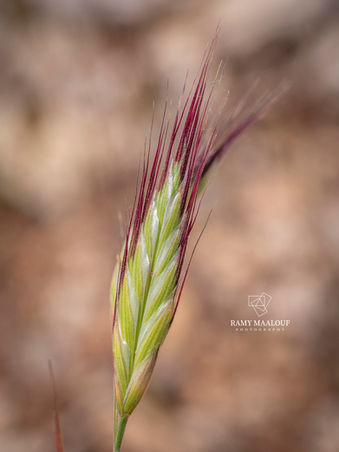Family |
Poaceae
Bromus danthoniae
Trin.
Bromus danthoniae Trin.
(Verz. Pfl. Casp. Meer.: 24; 1831. — Nouvelle Flore du Liban et de la Syrie, vol. 1, p. 127; 1966)
• Life-form & habit: Perennial, culms tufted, glabrous except at nodes or sometimes beneath the panicle.
• Leaves: Sheaths and blades villous or at least pubescent–scabrid; ligule acute, 2–3 mm, strongly hairy outside.
• Inflorescence & flowers: Panicle long-pedunculate, axis scabrid, branches often very short and rigid, occasionally longer (notably in the Jeziré), solitary or geminate, 1-spiculate. Spikelets 2–5 cm (without awns), slightly rounded at base, attenuate at apex, sometimes broad, nearly oval, 8–20(–30) flowers tightly imbricate, pale green becoming straw-coloured or sometimes tinged purple. Glumes ovate-lanceolate, subequal. Lemmas scarious on margin, obtuse, shortly bifid, with three awns: a main dorsal awn and two shorter lateral ones inserted higher. Awns yellowish to violaceous.
• Fruit: Caryopsis as in genus; not described in detail.
• Phenology: Flowers summer–autumn .
• Habitat & elevation: Pastures, degraded woodlands, dry fields; montane to steppe regions.
• Lebanese distribution: Ct. Tartous; Mi. Safita, ‘Ain Halakim; N Lattaquié: ‘Ain Haramiyé; Metn: Zahlé, Ksara, Chtaura; A.L. Ouadi-el-Harir; S.A.L. Ouadi-el-Qarn. Ve. Yammouné; Mi. Abey, Broummana, Bikfaya, Rayfoun, Terbol; Mm. Faraya, Roueissat, Kneissé, Dahr-el-Baidar; Beqa‘ (multiple localities).
• Native range: Afghanistan, Caucasus, Cyprus, East Aegean Islands, Greece, Iran, Iraq, Lebanon, Syria, Palestine, Transcaucasus, Turkey, Turkmenistan, Uzbekistan. (POWO)



